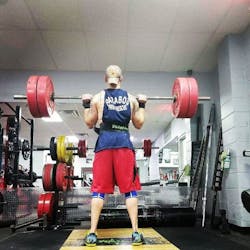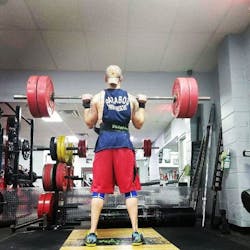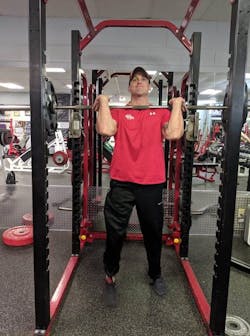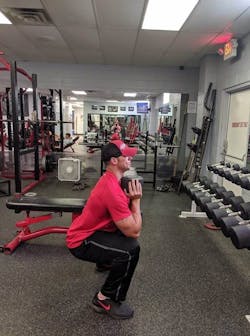Firefighter Fitness: Strength Training for Tactical Athletes
Health and wellness, functional training and proper training techniques have all been hot topics in the fire service the last couple of years. With so much information, it can be hard to tell what is right for you and your department. Injuries across the fire service continue to proliferate; the most common are knees, lower back and shoulders. The job is becoming more aggressive with new challenges and bigger, faster fires.
One issue that comes up consistently is improper use of strength training in the fire service. The reality is that from a health and performance standpoint, much of the fire service is in a deconditioned state. The prescription of a dynamic or functional training plan helps create a solid foundation from which to work and increase performance, while decreasing the risk of injury. What about those who already have a solid foundation? Or those who have been training at a high level for most of their careers? Do you want to put a ceiling over your top performers? The application of tactical strength training is highly effective in addressing the needs of all parties.The 5 physical structures of the body
Those attempting to take on tactical strength training must understand that for it to apply to your job, it must follow specific regimens while training our bodies in a way that replicates emergency operations. The first question is always, “What strength exercises should I do?” Let’s first look at the five physical structures in the body that facilitate movement: bones, joints, ligaments, tendons and muscle.
Bone is the substance that forms the skeleton of the body. It is the foundation for connective tissue and muscle and protects the vital organs. It is the frame of the body that everything connects to and therefore needs to be solid. Strength training helps improve bone density and lowers the risk of a break.
Joints are the junction of bones, muscles and connective tissue at which movement occurs. Weak joints need to be strengthened, or else risk long-term injury.
Ligaments are the primary connective tissues that connect bone to bone. They provide stability, input into the nervous system, guidance and the limitation of improper joint movement.Tendons are connective tissue that attaches muscle to bone and provides an anchor from which muscles produce force.
Last is the target of strength training: muscle. Muscles are bands or bundles of fibrous tissue in the body that have the ability to contract, which produces movement in or maintains the position of the various parts of the body.
There are three types of muscles in our body:
Type I—These “slow twitch” muscles are slow contracting, resistant to fatigue and have the greatest endurance.
Type IIa—These “intermediate twitch” muscles are fast contracting, fatigue quickly and generate power.
Type IIb—These “fast twitch” muscles are the fastest contracting, quickest to fatigue and generate the most power.
It is a lot to look at—a lot of moving pieces for this thing we call motion. When we add strength to that motion it can be a very complex process. This is why any firefighter wanting to add this type of training to their regimen must have a solid foundation of dynamic movements and baseline strength before starting.
Strength movements for firefighters
Now the question is asked, “What movements are the best strength movements for firefighters?” Most emergency operations happen on multiple planes, so the movements we select for the most part need to replicate that. The lower body is the foundation of our movement, making the squat a great way to strength train your lower body. Think about a time on a fast-moving operation, or maybe an everyday run, that you have not used your lower body in some way. The squat is a full-body training movement when done properly and is highly effective in both activating large amounts of muscle and also your central nervous system. There are many variations and ways of targeting specific goals, but in general can increase strength quickly for your lower body. This would translate to carrying large loads of equipment, climbing stairs, drag or push movements and crawling.
Next up would be the deadlift, one of the best lower body and core training movements. This is typically viewed as a high-risk movement, but with proper form and coaching, can be one of the most important movements. Picking things up off the ground, from debris to people, always requires us to use muscle. Think about your last lift assist. They are usually not in a wide-open area with plenty of space. You normally are in somewhat tight areas and have narrow passages to navigate. Training for a healthy posterior chain will help give you strength to do so. This training will also help to engage your core, which is going to dramatically decrease your risk of lower back injury on the job or off.
The clean and press is a compound, multi-joint movement that replicates many things while on emergency operations. From a ladder raise, lifting anything, working overhead and generating large amounts of force at once, the clean and press applied properly can improve strength and conditioning in all of these areas.
Training tips
Chances are if you are reading this article you believe in the proper application of strength training in the fire service. This is not for everyone, but from the leader’s point of view, do you want to put a ceiling over your top performers? When it comes to the human body, training should never become redundant. We need to continue to challenge ourselves and train our bodies to perform at a high level. The reality is that our job requires tactical athletes to perform high-level movements at a moment’s notice, because lives and property are on the line. We need to train our bodies accordingly.Bringing strength to our job is no different than bringing water, eventually it will be needed to get the job done. So, what would a program look like? There are so many different ways to structure a strength training program and all can be effective. One way is to break apart major muscle groups, like Day 1 being chest, Day 2 being back, Day 3 shoulders and arms, Day 4 legs, and so on. In this method you are giving more recovery time to major muscle groups, especially by separating legs and back by 72 hours to not overtax your central nervous system. So, what would a day look like? Here is an example I use for a lower body day geared toward fire athletes: How do you select your weight range? About halfway through the reps you should be burning in that muscle group, but never, ever sacrifice form for numbers.
Warm up:
25 goblet squats (light)
25 crunches
25 hyper-extensions
25 hamstring curls
Workout:
Squat—5 sets of reps of 15, 12, 10, 8, 8
Stiff leg deadlifts—3 sets of 10
Leg press—3 sets of 10
Stand calf raises—3 sets of 10
Farmers carries—3 sets (30 seconds on, 30 sec off)
Stretching:
Foam roll—3 minutes
Pigeon stretch—30 seconds on each side
Child’s pose—30 seconds
Reaching hamstring stretch—30 seconds on each side
Find what works best for you
Try this for your next training time. Again, there are so many methods that are effective, the key is your training needs to be applicable to what you do. It is imperative right now that we address the health issues in the fire service. When you look at the data, many of the injuries and deaths in our line of work are preventable. This job brings with it a certain amount of risk, but how much is acceptable on the things that are within our control? More importantly, what do you want your life to look like after you are done? We all have dreams, goals, people in our lives, and a future after we have moved on from this job. Sometimes we get lost in this job and forget that at some point it will be time for us to move on. The fire service is a major part of who we are, but it does not define us. If you let it, this job can take from you your mind, body and your time. Train hard to do the job the best you can and always improve but make yourself a priority and invest in what your time will look like after the job is done.
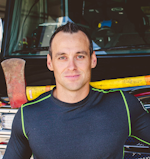
Brandon Green
Brandon Green is a captain with the Baraboo, WI, Fire Department and lead trainer for the department’s tactical fitness program. He is an instructor for the Madison College fire academy and a coach with the BEDYNAMIC training program. He is a graduate of the World Instructors Training School, which is recognized by NCCA, ACE and IACET, and has been coaching and training for 15 years. Green founded his own fitness system and fitness facility, and he trains all walks of life, from people who have neuromuscular diseases to professional athletes, but he specializes in tactical fitness. You can contact Green at [email protected].
